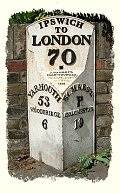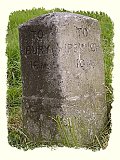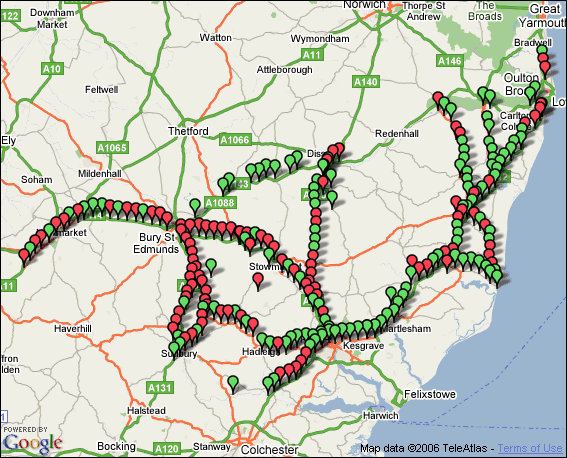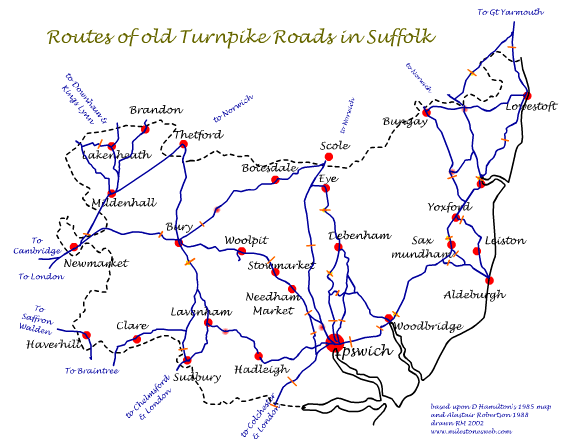Suffolk Milestones


Suffolk is a largely rural county, with a small number of market towns spread across the county. There were at least 200 milestones in the old county (as defined before 1974). About half of these survive today - quite remarkable given the passage of two and a half centuries, and a wartime edict in 1940 that waymarkers and signposts should be hidden or defaced to confuse the enemy in the event of a land invasion. (That was lifted in a couple of years and milestones should have been reinstated by 1943) The county town of Ipswich has all seven of its milestones in place. In contrast, not a single stone survives in Lowestoft.
Stone is generally in short supply in East Anglia. The first turnpike was enacted in 1711 for the roads between "Ipswich and Clayton etc", meaning the road to Stowmarket and "Hawleigh" (Haughley), and the road to Scole, including the branch at Yaxley to Eye. The stones are small, on this run, largely the routes of the modern A140 Norwich road and the B1113 Ipswich to Stowmarket roads.
Cast iron mileposts were often attached to the earlier milestones when the lettering became too worn to be read, and these lasted well across the intervening two centuries as long as there was no impact damage. They are common on the Ipswich to Southtown (now Great Yarmouth) Turnpike which passed through the county along a route now traced by the A12. This Turnpike connected with others reaching back to London through Essex. The London to Norwich route passed through Suffolk along the route of the modern A140. The county town of Ipswich, was linked with the market towns of Bury St Edmunds and Newmarket by turnpikes running east-west, the route now followed by the modern A14 dual carriageway.
Until the 17th century, the parish was responsible for maintaining the roads, and this was accomplished by appointing a local surveyor, who could call upon a few days labour from able-bodied parishoners. The weakeness of this approach was that those that benefited from road improvements were often not those doing the work, so standards varied widely. Surveyors were not encouraged to be too thorough by the parishoners!
 Increasing
mobility and developments in
domestic trade
and commerce in the 17th and 18th centuries put pressures on the
haphazardly organised and
poorly maintained road system. Parliament empowered responsible local
bodies with the
authority to place gates across the highway where a toll for passage
could be demanded.
That every user should pay in proportion to usage was a new principle
in highway
maintenance.
Increasing
mobility and developments in
domestic trade
and commerce in the 17th and 18th centuries put pressures on the
haphazardly organised and
poorly maintained road system. Parliament empowered responsible local
bodies with the
authority to place gates across the highway where a toll for passage
could be demanded.
That every user should pay in proportion to usage was a new principle
in highway
maintenance.
By a statute of 1663 the first road to be regulated in this way was established between Wadesmill, Hertfordshire, and Stilton, Huntingdonshire. Barley wagons on their way to the maltings were making the road almost impassable. However, the problems of the parish-based road system were not so pressing in Suffolk where the first turnpike act was passed almost fifty years later, in 1711.
Milestones were initially not a legal requirement for the turnpike trusts, but the General Turnpike Act of 1766 made them mandatory. However, some of the later routes such as the Ipswich to Eye via Debenham had no milestones. This was turnpiked in 1802 (Eye-Debenham) and 1812 (Debenham to Ipswich). The 1837 OS one-inch maps show tollgates but no milestones on this route, although it shows milestones elsewhere. Three long-distance routes which were turnpiked cross the county - the London to Norwich road (now the A140), the London to Great Yarmouth route, now the A12 and the Ipswich to Cambridge road (now the A14).
Suffolk also boasts a couple of fine obelisks, one at Nayland close to the Essex border and another at Hadleigh. Other than milestones, the county is rich in whimsical historical artefacts and home to a large number of churches.
listing of milestones in Suffolk | D Hamilton's 1983-87 milestone survey of Suffolk
MilestonesWeb V: 1.1Text and photographs © 2002 RM unless otherwise credited
Last updated 13 Jul 2002

